|
The Eastgate plane
crash
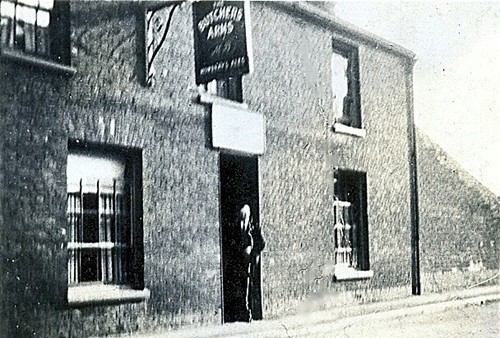
The Butcher's Arms in 1938 with landlord Charles Lappage at the door
A few minutes before midnight on
Sunday 4th May 1941, the people of Bourne were woken by the sound of
gunfire and the throb of aircraft engines as two planes battled it out
over the town.
World War II had broken out 18 months before and the German Luftwaffe was
engaged in a massive bombing campaign against sensitive British targets in
the industrial cities such as Sheffield, Birmingham and Newcastle. On this
occasion, a German Junkers 88 was bound for the East Midlands, probably
Grantham which was home to the Aveling Barford and
B-Marc munitions
factories, both producing weapons and other military equipment for the
armed services, when it was intercepted by a Royal Air Force Bristol Beaufighter and a dog fight ensued.
The Junkers loosed a number of incendiary bombs over the town but they
failed to inflict any damage and after several minutes of combat, with
flashes of machine gun fire lighting up the night sky, the Junkers was
badly damaged and the pilot injured and the plane nose-dived earthwards
with flames streaming from the fuselage.
It crashed on the Butcher’s Arms alongside the Bourne Eau at No 32
Eastgate, demolishing the public house, setting fire to the ruins and
killing seven people inside.
They included the licensee, Charles Lappage and his wife Fanny and two
relatives, Mrs Lappage's sister, Mrs Violet Jackson, and her daughter, Mrs
Minnie Cooper, who were also staying in the house, and an army officer and
a soldier who were billeted there although a third soldier died later from
his injuries.
THOSE ON DUTY
Les Jackson, aged 18, was fire watching at the premises of T W Mays and
Sons Ltd in Eastgate and was standing at the end of Willoughby Road
talking to others on duty when they heard the aircraft’s engines. In 1998,
then aged 76, and living in Stanley Street, he recalled that night. “The
aircraft appeared to be coming in from the coast”, he said. “Somebody said
it sounded like one of ours but then the cannons opened up and bits of
fuselage started falling all around us but we could not see a thing
because it was pitch black.
“We realised by the sound that the plane was in trouble because the engine
appeared to be going up and down like a yo-yo. We reckoned that the pilot
had been shot and the rest of the crew were trying to get him away from
the control so that they could take over but they didn’t succeed. Instead,
it went into a dive and the engines started screaming. It came down nose
first and must have been dropping at a terrific speed. We thought at first
that it had come down on the recreation ground, about a hundred yards
away, but it was far closer than that. I walked down towards the slipe
[the South Fen] and saw a parachute in the road and next to it one the
crew lay dead. I then went down Eastgate and saw what had happened.
“It was like nothing I had ever seen before. There were bodies all over
the place. The plane had sliced the pub away from the row of houses as
clean as a whistle. You would have thought it had been done by the
builders. The aircraft had gone straight through the building and the
engines had gone right into the ground for about 25 feet. The whole area
was covered in some sort of de-icing chemical and the smell from it was
terrible.
“I ran to the police station in North Street to get help and was quite out
of breath when I got there and worse still, when I told them that a plane
had come down in Eastgate and there was dead lying all over the place they
didn’t believe me at first. The inspector on duty said ‘You’re bloody
dreaming’ and so I told them to come back and see for themselves.”
Mr Jackson, who later served with the 11th Armoured Division in France and
Germany, added: “I remember the events of that night in every detail. It
was a very nasty experience. It was my first taste of war and you don’t
forget things like that. I had never seen a dead man before and I kept
thinking about it for weeks afterwards.”
A Home Guard unit was stationed at the Ship Inn, Pinchbeck, and at 11.30
pm, the duty guard saw the flashes of light from the dog fight over
Bourne, ten miles away. Private Tom Bray, aged 20, entered in the unit’s
report book: “Plane seen to fall in flames after two short bursts of
machine gun fire, west of guard point. Heavy detonations west to
north-west, intermittent flashes.”
Among those first on the scene was Ernie Robinson who was on duty with a
team of volunteers from the town's Civil Defence unit based at the Old
Grammar School in South Road that had been specially trained to deal with
air raid casualties. In 1998, then aged 97, he recalled the scene when
they arrived: “We heard the plane coming down”, he said. “It was only on
the other side of the Abbey Lawn and so we did not have far to go and we
turned out immediately.
“It was a shambles, a real mess. Soldiers from the Loyal Regiment were
billeted in Eastgate and one of them who had been on guard duty had been
killed. There was not a lot we could do to help and it was really a case
of clearing up as best we could. We found two of the German aircrew and
carried off their bodies to the stables behind the Six Bells public house
in North Street. The police station was next door in those days and they
took over as soon as we arrived and we left them searching through their
clothing to find some identification. Bourne was usually peaceful during
the war years but it certainly was not on that occasion which turned out
to be one of the busiest nights of the war.”
CIVILIAN WITNESSES
Vera Bristow and her husband Roland were living with her parents at Walton
House, Eastgate, at the time of the crash. The house was just a few yards
away from the Butcher’s Arms and although the property was not damaged,
telephone wires just six feet above the roof were slashed by the plane as
it came down. Sixty years later, in October 1998, Vera, then aged 80, and
Roland, aged 81, then living in Harvey Close, Bourne, relived the
experience. Roland was on war work at the B-MARC arms factory in Grantham
which made the machine guns for RAF fighter planes and when the cannon
shots began bursting over Bourne that night he was able to identify the
interceptor plane from the sound of its guns.
“We had just gone to bed”, he said, “and once I heard the noise I could
tell it was a Bristol Beaufighter straight away. Then we heard the German
plane with its engines screaming over the rooftops. You can imagine the
noise as it came down. I will never forget it.”
They dressed quickly and went out into the street. “The Butcher’s Arms was
totally devastated”, said Vera. “Most of it had been knocked into the
river and the entire aircraft was buried in the rubble with green fuel oil
running down the road. The smell was quite awful.”
Other soldiers staying at the public house had been injured and Vera took
them back to their home, bandaged their wounds and gave them mugs of hot
tea.
Stephen Hare, aged 22, who was home on leave from the RAF and staying with
his grandmother at her house in Hereward Street, Bourne, saw the plane
come down from his bedroom window. “I was woken by a burst of gunfire
followed a few seconds later by another”, he said. “I looked out of the
window and couldn’t see anything except what I thought was a shooting star
flashing across the night sky. Then all of a sudden I realised it was a
plane. It did not appear to lose height at first but then suddenly started
to fall although I had no idea where it had come down.”
Within minutes, residents living nearby began milling about the streets,
some who had hurriedly dressed while others were wearing pyjamas and
dressing gowns, all trying to find out what had happened.
Albert Bull, aged 19, was a nephew of the landlord, Charles Lappage, and
lived nearby at No 57 Willoughby Road. “That night, we heard the bullets
exploding and I was told later that the RAF plane had chased the bomber
all the way from Hull”, he recalled in 1998. “We went out into the street
as soon as we heard the crash and the police told us what had happened.
They had already cordoned off Eastgate and were stopping anyone going
through but when they realised that my mother Annie was the landlord’s
sister, they let us through. Mum was in tears and very upset and I tried
my best to comfort her but it was a very difficult time.”
Mrs Kathleen Ferguson, then aged 18, was living with her parents, Florence
and James Hanford, in Eastgate, just three doors away from the public
house, and they were woken by the commotion overhead. “We saw the planes
from our back bedroom window and when it crashed, all hell broke loose”,
she recalled later. “Soldiers started banging on our doors telling us to
get out in case there were unexploded bombs on board and when we got into
the street there was fire and rubble all over the place. We just did not
know what was happening. It was a most terrible experience.”
THE AIRCRAFT INVOLVED
|
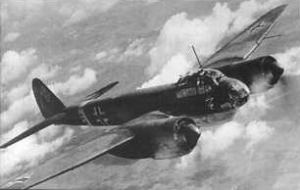 |
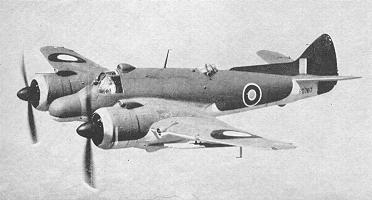 |
|
The Junkers 88 (left) similar to that which
crashed on the Butcher's Arms and the Bristol Beaufighter (right)
which shot it down after an aerial fight over the town. |
The Junkers or Ju 88 was one of the most important and versatile German
aircraft of World War II, having been developed by the Luftwaffe for every
kind of combat role, including dive bomber, night fighter, day
interceptor, photo reconnaissance, tank destroyer, and even as a
pilot-less missile, the forerunner of the flying bomb. The Ju 88 made its
first flight on 21st December 1936 and hundreds were still in use when the
war ended in 1945.
The Bristol Beaufighter was first used by the Royal Air Force in April
1940 as a high performance night fighter equipped with airborne
interception radar and successfully operated against the German night
raids in the winter of 1940-1941. It was later used by Coastal Command as
a strike fighter when the original formidable gun armament was retained
but rockets and torpedoes were added giving it an even greater fire power.
Not only did the Beaufighter operate with distinction in North West
Europe, but also a considerable reputation was earned in the Middle and
Far East.
THE GERMAN CREW
The Junkers had a crew of four and three of them baled out but two were
killed when their parachutes failed to open and their bodies were found
some distance away. The pilot, Adam Becker, aged 28, had remained at the
controls and was buried in the wreckage of the inn where the aircraft had
embedded itself in the foundations. The other two who lost their lives
were Reinhold Kitzelmann, aged 22, radio operator, and Karl J Focke, aged
22, observer.
A third crew member, the rear gunner, Rudolf Dachsesel, survived. He
landed by parachute south of the town near Northorpe and was slightly
injured but gave himself up to the Home Guard next day after walking into
Bourne along South Road. He later returned with a police escort to recover
a revolver he had hidden at the roadside a few yards from Baldock’s Mill.
The escort included Constable Ron Jarvis who was based at the police
station in North Road, Bourne, from 1939-41 and had helped to clear the
rubble from the crash site. “The airman told us that as soon as the plane
was hit, he pushed his guns out and decided to follow them”, he recalled
in 1998. “We put him in the cells but he was not with us for long before
an army unit arrived and took him away.”
The body of the pilot, Adam Becker, was found after extensive digging by
the rescue services and all three of the bomber crew who had been killed
were buried in the town cemetery at Bourne the following Thursday after a
short graveside service conducted by the Vicar of Bourne, the Rev Charles
Horne. In 1959, the War Graves Commission arranged for their exhumation
and reburial at the war memorial cemetery at Cannock Chase in
Staffordshire.
Engineering experts from the Ministry of Defence arrived next day and
removed what was left of the aircraft for workshop examination but they
did not recover everything and it is believed that one of the engines and
other parts of the wings and fuselage still lie on the bottom of the
Bourne Eau.
THE ROYAL AIR FORCE CREW
Although they completed a successful mission in shooting down a German
bomber, the crew of the Bristol Beaufighter took no pleasure in the
incident because of the subsequent loss of life and property. Flight
Lieutenant John Hunter-Tod was the plane’s radar officer and navigator and
in 1993, he wrote to Roland Bristow explaining their feelings. In May
1941, he was serving with No 25 Squadron (Beaufighters) based at RAF
Wittering, near Stamford, and flying with the commanding officer, Wing
Commander David Atcherley, at the controls. The Beaufighter had been
specially fitted with radar to enable it attack Luftwaffe bombers on their
nightly raids over Britain.
Hunter-Tod, then living at Dartmouth, Devon, said in his letter to Mr
Bristow: “I remember the event quite well although some of the details are
now a bit hazy. The morning after the incident, we went to Bourne in a
staff car to see our victim, not realising that we had scored an own goal.
What we saw certainly took the gilt off the gingerbread and we tactfully
withdrew. I knew that several soldiers billeted at the pub had been killed
but not that the place had been obliterated. What a shambles! You were
lucky not to have had the Ju 88 landing on you.”
David Atcherley (1904-1952) was commissioned in the RAF in 1927 and served
with distinction, becoming a legend in the service with his twin brother
Richard and achieving the rank of Air Vice Marshal. He was awarded the DFC
(1942), the DSO (1944), the CBE (1946) and the CB (1950) shortly before he
died.
Sir John Hunter-Tod (1917-2000) was commissioned in 1940, serving with
Fighter Command and in the Middle East, and after a notable war record,
had a series of important defence posts, being promoted Air Marshal in
1971 before retiring in 1973.
THE VICTIMS
|
The landlord and his wife were killed in
the crash. They were Charles Edward Lappage, aged 63, and his wife Fanny
Elizabeth, aged 59, who had been running the public house for ten years.
Mr Lappage was born in Bourne but when he left school, he moved away to
work for an engineering firm in Grantham where he met and married Fanny
but gave up his factory job after a bout of pneumonia and they moved back
to his home town in 1931 to take over the Butcher’s Arms. He was a quiet
but reliable man and devoted to his family and the couple enjoyed running
the pub but were beginning to talk about retirement. They had one son,
George, who had married Eva and were living in Grantham.
Also killed were two relatives who were visiting, Mrs Lappage's sister,
Mrs Minnie Gertrude Cooper, aged 62, and her daughter, Mrs Violet Frances
Jackson, aged 29, who had only been married for a fortnight. Her husband,
George Jackson, from Hull, had been serving as a fitter with the RAF at
one of the nearby air bases when they met and married just a few days
before his unit
embarked for Egypt. |
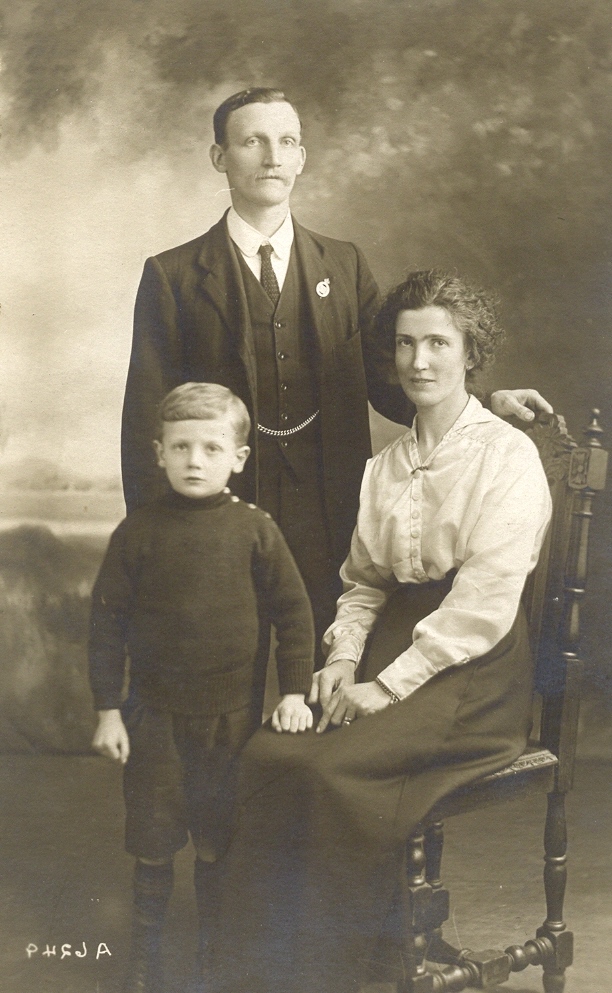
Charles and Fanny Lappage with young
son George |
The soldiers who were killed were all serving with the Loyal Regiment
(North Lancashire) which was based at Grimsthorpe Castle from 1940-41 with
tented accommodation in the grounds although some platoons were billeted
at various locations throughout Bourne, including Eastgate.
They were Lieutenant Harold Schofield, aged 28, Private Harrison Mackean,
aged 33, and a Welshman, Private Clifford James, aged 29, who was fatally
injured and died in hospital at Sleaford a few days later. He was a
regular soldier who had served in India and Palestine and had even
survived Dunkirk. Six other soldiers were hurt in the incident but all
recovered from their injuries and returned to duty.
One of their colleagues, Private John (Hank) Hankinson, who was also
billeted in Eastgate for a time, remembered the incident in November 1998
when he was 81 and living at Worsley, Manchester. “We all made many
friends in the town during our stay and certainly livened the place up at
weekends”, he said. “There were one or two regimental bandsmen with us and
they used to play for dances at the Corn Exchange on Fridays and Saturdays
and they were always popular events. The people were really nice and
friendly, especially some of the girls, and many long term relationships
were formed.
“The loss of Taffy James affected us most because he was a real old
soldier who had seen much service, a very witty chap and a noted character
in the regiment who was known and liked by everyone.”
A month after the tragedy, the Loyal Regiment moved out of Bourne bound
for North Africa where it fought with distinction in the desert campaign
against Rommel’s Afrika Corps and one officer won the Victoria Cross,
awarded posthumously.
THE PUBLIC HOUSE
The Butcher’s Arms in Eastgate was built of brick and blue slate and dated
back to the early 19th century although there was probably a beer house on
the site prior to that. It became a popular drinking place for fen farmers
and agricultural workers, particularly between 1885 and 1913 when the
licensee was Samuel Bolton because he also farmed in North Fen and so
crops and the weather was a regular topic of conversation. Later, during
the early years of the 20th century, it was patronised by men working at
the Hereward Labour Camp that was established in Bourne to help ease the
national unemployment crisis.
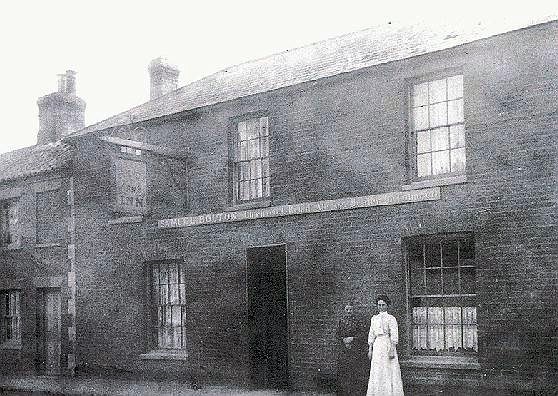
The licensee when this photograph was taken
of the Butcher's Arms between
1885 and 1913 was Samuel Bolton, who also farmed in North Fen, and the
two ladies posing for the camera appear to be his wife and daughter.
Many of them came from the north of England
and they started using the pub after discovering that it served their
favourite mild beer at 4d. a pint. During the Second World War it became
the local for soldiers billeted at houses in the Eastgate area and
sergeants from the Loyal Regiment commandeered the front sitting room as
their mess while visiting officers and padres were often given
accommodation during their stay.
INFORMING THE RELATIVES
One of the most difficult duties for the emergency services in times of
disaster is in informing relatives of what has happened. The next of kin
of soldiers who were killed were officially told by the military
authorities according to a set procedure, often by letter, but it was the
task of the police to contact families of those civilians who had lost
their lives and this usually involved a personal visit. Charles and Fanny
Lappage had a son, George, who was living in Grantham with his wife Eva
and their two children, Trevor and Joan, and therefore he was the first to
be contacted with the tragic news.
George died in 1987 aged 76 but in October 1998, Eva, then aged 82,
recalled the dramatic events of that fateful night. There was an air raid
on Grantham that night and the family had just gone to bed after the all
clear had sounded when there was a knock at the door.
“Two policemen stood outside”, said Eva, who answered. “They said: ‘Would
you mind going inside and sitting down. We had some bad news for you.’ The
crash had only happened a short time before and they were unable to say
exactly what had happened although it did involve George’s parents and the
Butcher’s Arms. We dropped Trevor off a friend’s house and took Joan with
us and hired a taxi to take us to Bourne but halfway there a wheel broke
and it took so long to repair that it was dawn before we finally arrived.
“The taxi got to Eastgate and there were crowds milling about at the end
of the street but the police were not letting anyone through until someone
shouted ‘Here’s Mr and Mrs Lappage’ and we were escorted to the scene of
the crash and I saw what had happened. All you could see was the tail end
of the plane sticking out from a pile of rubble and the wreckage was still
smouldering. It was a horrible sight and one that I have never forgotten.”
She and George retrieved a few items from the ruins including Charles’
watch chain that Eva still wears as a necklace. But there was little else
they could do and after a few hours visiting friends, they returned home
to Grantham. Coincidentally, they had been due to visit Bourne for the
weekend but had called off the trip at the last moment. "Had we gone, we
too would have been killed", recalled Eva. "The irony was that both Minnie
and Violet also lived in Grantham and had gone to Bourne as a respite from
the bombing because the town was a target as a result of the munitions
factories based there."
A joint funeral was held in Grantham later that week for all four of the
family who died in the crash and all are buried in the town cemetery.
|
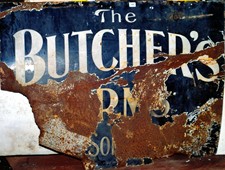 |
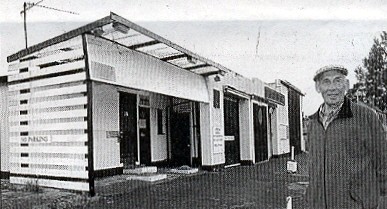 |
|
The remains of the public house sign which
was salvaged by Jack Lovell who years later hung it in his garage
that was built on the site of the plane crash. |
THE AFTERMATH
During the war, salvage teams had no time to retrieve debris after such
incidents and so the hole was filled in and the site of the Butcher's Arms
levelled. It remained derelict until after the war when it was bought for
a garage development by the late Jack Edmund Lovell (1929-2005) of
Riverside Motors which opened in 1959.
Five years later, in August 1964, he was expanding the business with
the installation of new underground petrol storage tanks and a JCB was
brought in to dig the necessary holes to accommodate them. A small crowd
had gathered to watch the work proceed and there was much talk of the
bomber crash which was still fresh in many people’s minds.
Digger driver Derek Bowers, aged 27, was at the controls and once his
machine began to excavate the site, fragments from the plane and even
machine gun bullets were being unearthed. The machine then struck
something more substantial and made of metal. “I hit it with the bucket”,
recalled Derek in later years. “I thought at first that it might be a
wheel from the undercarriage and I began hammering away in an attempt to
move it but it wouldn’t budge. Somebody went down into the hole to have a
look – I think it was Bill Darnes – but he got out pretty quickly when he
realised it was a bomb.”
The digger had in fact unearthed a 1,100 lb. unexploded bomb almost eight feet
below the surface that had buried itself so deeply in the ground that its
presence was undetected when the crater caused by the plane crash had been
covered over and left 23 years before. The police were alerted and they
called in a bomb disposal expert but a preliminary investigation revealed
that it was not likely to explode although the area was cordoned off for
the night and residents in Eastgate spent many anxious hours fearing that
it might explode and some even went to sleep with friends and relatives as
a safety precaution.
The following morning at 3 am, a squad arrived from RAF Newton near
Nottingham and loaded the bomb on to a lorry and took it away for
disposal. The officer in charge said that it was still "live" in that it
still contained its high explosives but it was "safe" in that the fuses
were not energised. The excavations also unearthed two clips of live
ammunition, electrical wiring and a fuel pipe from the aircraft.
Jack Lovell said afterwards: “A few of our older residents who remembered
the crash turned out to watch the excavations half-expecting us to find
something and they were not disappointed. What they did not realise was
that the bomb would have blown the street up if it had gone off. I would
not be surprised if there were a few more bombs down there still.”
He was only 13 at the time of the plane crash and living in the Austerby
but he joined dozens of more curious boys who flocked there on the Monday
morning to witness the devastation. “We went there looking for bits of the
aeroplane and even bullets as souvenirs”, he said. “One thing I did get
was the original sign from the Butcher’s Arms which was badly damaged and
I hung it in the garage after it was built as a reminder of that terrible
night.”
NO MEMORIAL
After Jack retired from business, the garage was demolished in 2001 and
new homes built the following year now occupy the site but there is no
indication of the tragedy that occurred there more than half a century
ago. Memories of the disaster were revived in 1998 when the Stamford
Mercury launched a campaign to provide a lasting memorial to those who
died, both German and British, in order that the younger generation might
be reminded of the conditions that existed during those wartime days.
The Mayor of Bourne, Councillor Don Fisher, gave his full support to the
idea and although he himself was not a resident at the time of the crash,
he felt it was an important event in the town’s history that should be
commemorated. He told the newspaper: “There are still many people in
Bourne who witnessed the event or went to look at the scene of the
disaster afterwards and therefore it should be remembered as part of the
consequences of the war to this town and one that came as a tremendous
shock to the community.”
There was also support from members of the Lappage family and the design
for an engraved plaque to be financed by public subscription and placed in
the Abbey Church was contemplated but despite an intensive campaign by the
newspaper over several weeks, interest waned and the idea of a memorial
came to nothing.
|
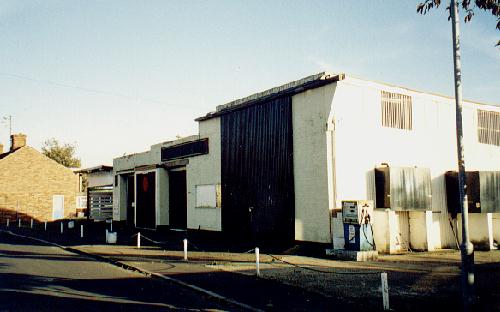
|
|
Jack Lovell's garage (above) on the site of
the former Butcher's Arms. It
was demolished 2001 and the site is now occupied by houses (below).
|
|
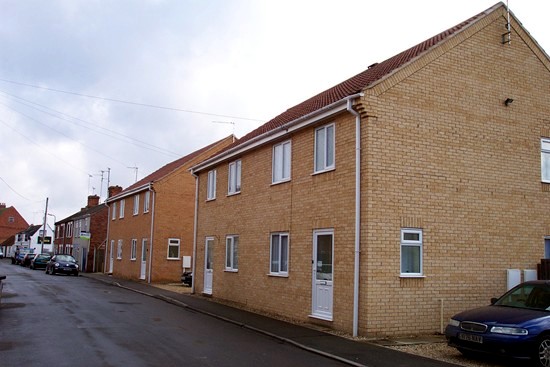 |
|
NEWS REPORTS
The plane crash was reported by the Stamford Mercury on Friday 9th
May 1941 but because of wartime restrictions on news coverage concerning
enemy action over Britain, the place name was not given to avoid divulging
information that might be of use to the enemy:
PLANE CRASHES ON
INN - ENEMY MACHINE BROUGHT DOWN
SEVERAL CASUALTIES
When a Junkers 88 was shot down over a town during the weekend, it crashed
into an inn and killed several of the occupants and injured another. The
crew of the enemy plane had loosed a number of incendiaries upon the town
which failed to do any damage, when a night fighter came up and shot it
down with a few short bursts of machine-gun fire. The 63-year-old
licensee, his wife and two relatives, Violet Frances Jackson and Minnie
Gertrude Cooper, who were staying in the house, were killed. An Army
officer and two soldiers who were staying at the house were killed and
another soldier was injured.
The Nazi plane was in flames as it came down and set the inn on fire, but
the local Fire Brigade and members of the civil defence services worked
splendidly in putting out the blaze and in rescue work. Of the plane's
crew, three baled out, but the parachutes of two failed to open and they
were killed. The other gave himself up. The pilot had remained in the
plane and was buried beneath the wreckage of the inn.
At the war’s end, when censorship of news reporting
was being lifted, the Stamford Mercury carried a story about the
extent of enemy air raids over the Bourne area and the public learned
officially for the first time about what had happened in Bourne and other
surrounding towns:
FULL STORY OF AIR RAIDS IN KESTEVEN
ONLY 29 PARISHES ESCAPE NAZI FURY
The full story of Kesteven’s suffering
under attack from the air throughout the years of war has been issued by
Mr F Coulson, county ARP officer, at the request of the county council.
The figures of casualties – 107 dead (mostly in Grantham), 96 seriously
injured – were given to the council three months ago, but there is much
detail in the present report that is new.
Four enemy aircraft crashed in our county: Junkers 88 came down at Bourne
(4 May 1941), at Market Deeping (22 June 1941), at Barrowby (11 October
1941), and a Dornier 217 at Boothby Graffoe (15 January 1943).
The crash at Bourne caused a serious incident resulting in loss of life.
The plane fell in flames at eight minutes before midnight on the Butcher’s
Arms, set it on fire, completely demolishing the building, and trapping a
number of people who were killed.
The plane, a total wreck, embedded itself in land below the foundation of
the house. A number of soldiers who had run from their billets were killed
and others injured. The fire prevented rescue parties working on the
building for some time and each time an attempt to move debris was made,
flames broke out afresh as the whole plane was drenched with petrol.
The death toll was seven killed and six injured. Of the four Germans in
the machine, two were found dead some little distance away, another,
slightly injured, gave himself up and the fourth died in the crash.
|
NOTE: Acknowledgments to the Stamford Mercury for its
reports on the incident carried in
October-November 1998 and to Mrs Eva Lappage and her son Trevor for
sharing
their memories and family photographs.
See also The man who dug up a
1,100 lb. bomb

Go to:
Main Index Villages
Index
|








